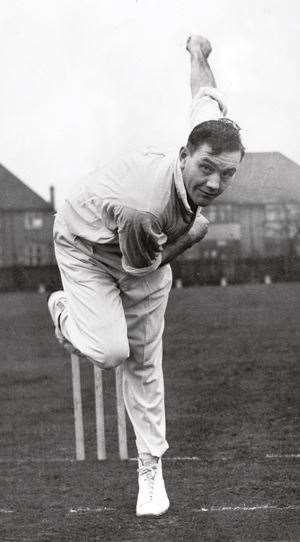This post-war Englishman’s cross-seam grip produced the ultimate Fast bowler’s delivery: an in-swinging leg-cutter.
 “My aim was to spin the ball at speed!” It was a tactic that out-witted even The Don.
“My aim was to spin the ball at speed!” It was a tactic that out-witted even The Don.Sometimes an innovation is only of benefit to the innovator – and, by extension, his team, if it means they win games. This is because their invention is perfectly suited to their own unique mechanics. No one else could do what Alec Bedser achieved when he decided to change the way he gripped a cricket ball. It’s not so much its effect on the game of cricket that’s significant as its effect on the result of the Test matches he played and the way it took an already significant career to an entirely new level. Furthermore, he’d come up with the ultimate cricket invention: a delivery that could dismiss Don Bradman ... repeatedly.
Bedser was one of the greatest bowlers ever produced by England; a powerful and strapping fast-medium bowler in the fine English tradition which had already produced men of the calibre of S.F.Barnes, Bill Voce and Maurice Tate.
By the time Bedser had landed in Australia in 1946-47, he’d already established a reputation as one of the very top grade of bowlers in world cricket. It was the first post-war Ashes series and Australia’s Don Bradman, at 37, was playing as though it was 1938. He’d already accumulated two centuries and two half-tons when the fourth Test came around.
The Englishmen looked war-ravaged and unhealthy compared to the Aussies, but the powerful Bedser was never a pushover.
During the series, Bedser had been concerned about his effectiveness against a formidable Australian batting side. He was already the mainstay of the English attack, and felt he needed something else. Specifically, he was worried that his in-swingers were being read too well by Bradman and Sid Barnes.
A self-reflective and quick learner, Bedser decided to change his grip to minimise the swing. The Adelaide pitch would be helpful, but not overly, if he could just keep the rampant scoring to a minimum. In order to achieve the effect he desired, Bedser gripped the ball so the seam ran across his fingers, rather than in line with them. The effect was immediate and dramatic. It produced a late in-swinger that turned viciously from leg when it pitched. It was that added feature of nasty cut that Bedser had unexpectedly added to his armoury. It helped him produce what might have been dubbed the “Ball Of The Century” if he’d had the benefit of television, august commentators, replays and modern hype that Shane Warne enjoyed when he bowled his millennial delivery.
Bedser had already experimented with his new grip during Barnes’ famous innings of 234 (the same score as Bradman) in Sydney. When he produced it and the ball cut ferociously away, Barnes cast a suspicious glance at the pitch, before bursting out with, “What the hell’s going on?” Today, such a reaction would be a dead giveaway any bowler would relish. Bedser later said, “My aim now was to spin the ball at speed!” He practised until he was able to pitch the delivery perfectly.
It was Bradman who was shaping up to him in the first innings of that Adelaide Test when Bedser bowled the unplayable ball. It swung from the off, pitched outside leg, jagged back in and took out the contorted, desperately defending Bradman’s off stump. It was, in fact, the fast-bowler’s version of Warne’s “Gatting Ball” and the effect on Bradman was similar to that of Warne’s ball on the portly Pom. Bedser’s prize was, of course, much bigger.
At the time, Australia was chasing an English total of 460. It was a batsman-friendly pitch, and the game featured five centuries, which made Bradman’s first-innings duck even more dramatic. Bradman often said it was the best delivery ever to get his wicket, and that Bedser was the most difficult bowler he’d faced in Test matches. He got Bradman five successive times with similar deliveries. Three of those times he set a trap for The Don, whom he knew would develop an eye for the delivery, and had him caught at short backward leg by Len Hutton.
Though Bedser was able to revert to his old style that produced his prodigious in-dippers, the cross-seam grip – combined with the peculiar mechanics of Bedser’s action – gave the big quick another potent weapon.
Five years later, at Trent Bridge, he produced yet another devastating spell, taking 14-99 for the match against the Aussies, the ball dipping and then turning from leg fiercely as Bedser employed his deadly grip.
Bedser went on to forge a career as a magnificent, versatile and intelligent fast bowler without whom England would’ve been lost. In his 51 Tests, he bagged 236 wickets at 24.89 apiece. No one could ever claim the great Bradman as his “bunny”, but Bedser came as close as anyone to rendering him helpless against his best deliveries.
– Robert Drane
Related Articles

How to train like Aussie sevens star Cameron Clark

How to train like Aussie sevens star Cameron Clark













